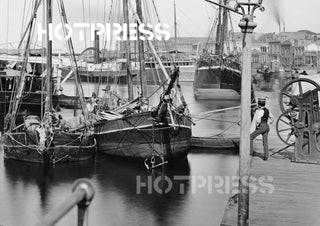1874 Queen's Wharf
Description
Charles Bayliss took this beautiful photo in 1874 of the area around Queen's Wharf. This wharf was located on the northern bank of the Yarra River, just south of Flinders Street, at the southern end of William Street.
The area around Queen's Wharf was the original landing area in 1835, but it was just a rough and muddy riverbank then, but within a year it had been turned into a workable wharf. At this point in the Yarra there was a naturally wide section, known as the Turning Basin, where ships could turn around to get back to the Bay. Within a few years the river bank was better defined and wooden piles were put into the river bank to support the increasing amount of trade that was coming into early Melbourne.
Bayliss' assistant can be seen standing on the wharf's edge. Behind him is Flinders Street, which runs along the Yarra, with the main buildings being hotels and customs storage. There is enough land between the river's banks and Flinders Street to allow the landing and transfer of many types of goods and produce.
By 1874 Melbourne was a very rich and busy city. The wharves had been extended for a full mile to the west (as seen in the photo) and both the north and south banks were used for goods and passenger transport. This photograph shows an intriguing mix of sail and steam powered vessels.
Between the masts of the two small yachts we can see the black funnel of the "Black Eagle" paddle steam tug. There was a small fleet of steam tugs that were kept busy helping sailing ships move up and down the river, as it was a 7-mile (11.5kms) narrow and winding journey from the City to the Bay proper.
All text © HotPress
Photographer was Charles Bayliss.
This is a digitally retouched reproduction of the original held by the State Library of New South Wales. All prints are reproduced without the HOTPRESS watermarks.
Our team of conservators have worked on a high resolution digital image in order to remove blemishes and artifacts such as stains, mould, scratches and damage caused by the handling of the original. We strive to provide authentic representations of the original work that are suitable for enlargements that retain the tones and character of the original.
Description
Charles Bayliss took this beautiful photo in 1874 of the area around Queen's Wharf. This wharf was located on the northern bank of the Yarra River, just south of Flinders Street, at the southern end of William Street.
The area around Queen's Wharf was the original landing area in 1835, but it was just a rough and muddy riverbank then, but within a year it had been turned into a workable wharf. At this point in the Yarra there was a naturally wide section, known as the Turning Basin, where ships could turn around to get back to the Bay. Within a few years the river bank was better defined and wooden piles were put into the river bank to support the increasing amount of trade that was coming into early Melbourne.
Bayliss' assistant can be seen standing on the wharf's edge. Behind him is Flinders Street, which runs along the Yarra, with the main buildings being hotels and customs storage. There is enough land between the river's banks and Flinders Street to allow the landing and transfer of many types of goods and produce.
By 1874 Melbourne was a very rich and busy city. The wharves had been extended for a full mile to the west (as seen in the photo) and both the north and south banks were used for goods and passenger transport. This photograph shows an intriguing mix of sail and steam powered vessels.
Between the masts of the two small yachts we can see the black funnel of the "Black Eagle" paddle steam tug. There was a small fleet of steam tugs that were kept busy helping sailing ships move up and down the river, as it was a 7-mile (11.5kms) narrow and winding journey from the City to the Bay proper.
All text © HotPress
Photographer was Charles Bayliss.
This is a digitally retouched reproduction of the original held by the State Library of New South Wales. All prints are reproduced without the HOTPRESS watermarks.
Our team of conservators have worked on a high resolution digital image in order to remove blemishes and artifacts such as stains, mould, scratches and damage caused by the handling of the original. We strive to provide authentic representations of the original work that are suitable for enlargements that retain the tones and character of the original.

